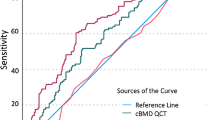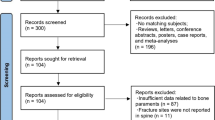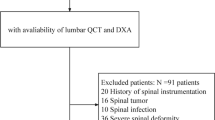Abstract
Summary
Lumbar spine volumetric bone mineral density (BMD) measured using quantitative computed tomography (QCT) can discriminate between postmenopausal women with low areal BMD with and without vertebral fractures. QCT provides a 3D measure of BMD, excludes the vertebral posterior elements and accounts for bone size. This knowledge could contribute to effective treatment targeting of patients with low BMD.
Introduction
We evaluated the ability of lumbar spine bone mineral apparent density (BMAD), trabecular bone score (TBS) and volumetric bone mineral density (vBMD) to discriminate between postmenopausal women with low areal bone mineral density (aBMD) by dual-energy X-ray absorptiometry (DXA) with and without vertebral fractures. The discriminatory ability of lumbar spine aBMD was compared with that of BMAD, TBS and vBMD.
Methods
We studied three groups of postmenopausal women, i.e. group 1, aBMD T-score < − 1.0 and ≥ 1 vertebral fracture (n = 39); group 2, aBMD T-score < − 1.0 and no vertebral fracture, age- and aBMD-matched to group 1 (n = 34); group 3, aBMD score > − 1 and no vertebral fracture, age-matched to group 1 (n = 37). Lumbar spine aBMD was measured by DXA. BMAD was calculated using the DXA scan results. TBS was derived following DXA scan image reanalysis. Lumbar spine vBMD was assessed by quantitative computed tomography and Mindways Pro software. Differences in variables between groups 1, 2 and 3 were examined using general linear univariate modelling approaches. Area under the receiver operating characteristic (ROC) curve was calculated for BMAD, TBS and vBMD to determine the ability of lumbar spine measurement variables to discriminate between group 1 and group 2. A comparison of ROCs was performed.
Results
Lumbar spine BMAD and TBS measurement variables were similar for groups 1 and 2. However, vBMD was significantly lower in group 1 and could discriminate between those women with low aBMD with (group 1) and without vertebral fractures (group 2).
Conclusions
We conclude that lumbar spine vBMD may discriminate well between postmenopausal women with low aBMD with and without vertebral fractures as it provides a 3D measure of bone mineral density, excludes the posterior elements of the vertebrae and takes into account bone size. A unique feature of the SHATTER study is that groups 1 and 2 were matched for aBMD, thus our study findings are independent of aBMD. Furthermore, we observed that neither BMAD nor TBS could distinguish between women with low aBMD with and without vertebral fractures. The knowledge gained from the SHATTER study will influence clinical and therapeutic decision-making, thereby optimising the care of patients with and without vertebral and other fragility fractures.

Similar content being viewed by others
Abbreviations
- AUC:
-
area under the curve
- aBMD:
-
areal bone mineral density
- BMAD:
-
bone mineral apparent density
- TBS:
-
trabecular bone score
- vBMD:
-
volumetric bone mineral density.
References
Van Staa TP, Dennison EM, Leufkens GM, Cooper C (2001) Epidemiology of fractures in England and Wales. Bone 29(6):517–522
Calculated using mid 2013 population data [i] and osteoporosis incidence from [ii]. [i] Office of National Statisticss, 2014. Annual Mid-year Population Estimates, 2013. Available at: http://www.ons.gov.uk/ons/rel/pop-estimate/population-estimates-for-uk--england-and-wales--scotland-and-northern-ireland/2013/stb---mid-2013-uk-population-estimates.html (last accessed on 6 August 2019).
Kanis J, Johnell O, Oden A, Jonsson B, Laet C, Dawson A (2000) Risk of hip fracture according to the World Health Organisation criteria for osteopenia and osteoporosis. Bone 27(5):585–590 Calculated using mid 2013 population data [2] and osteoporosis incidence from [3]
Ballane G, Cauley JA, Luckey MM, El-Hajj Fuleihan G (2017) Worldwide prevalence and incidence of osteoporotic vertebral fractures. Osteoporos Int 28(5):1531–1542
Klotzbuecher CMRP, Landsman PB, Abbott TA III, Berger M (2000) Patients with prior fractures have an increased risk of future fractures: a summary of the literature and statistical synthesis. J Bone Miner Res 15:721–739
Black DM, Arden NK, Palermo L, Pearson J, Cummings SR (1999) Prevalent vertebral deformities predict hip fractures and new vertebral deformities but not wrist fractures. Study of Osteoporotic Fractures Research Group. J Bone Miner Res 14(5):821–828
Lindsay R, Silverman SL, Cooper C, Hanley DA, Barton I, Broy SB, Licata A, Benhamou L, Geusens P, Flowers K, Stracke H, Seeman E (2001) Risk of new vertebral fracture in the year following a fracture. JAMA 285(3):320–323
Kuet KP, Charlesworth D, Peel NFA (2013) Vertebral fracture assessment scans enhance targeting of investigations and treatment within a fracture risk assessment pathway. Osteoporos Int 24:1007–1014
Kanis JA, Melton J, Christiansen C, Johnston CC, Khaltaev N (1994) The diagnosis of osteoporosis. J Bone Miner Res 9(8):1137–1141
Kanis JA, McCloskey EV, Harvey NC, Johansson H, Leslie WD (2015) Intervention thresholds and the diagnosis of osteoporosis. J Bone Miner Res 30(10):1747–1753
Bliuc D, Alarkawi D, Nguyen TV, Eisman JA and Center JR (2015) Risk of subsequent fractures and mortality in elderly women and men with fragility fractures with and without osteoporotic bone density: the Dubbo osteoporosis epidemiology study. J Bone Miner Res 30(4):637–646
Glüer CC (2017) 30 years of DXA technology innovations. Bone 104:7–12
Na L, Xin-min L, Xu L, Wei-jie S, Cheng X-g, Wei T (2013) Comparison of QCT and DXA: osteoporosis detection rates in postmenopausal women. Int J Endocrinol 2013:895474, 5 pages. https://doi.org/10.1155/2013/895474
Yu W, Glüer C-C, Fuerst T, Grampp S, Li J, Lu Y, Genant HK (1995) Influence of degenerative joint disease on spinal bone mineral measurements in postmenopausal women. Calcif Tissue Int 57(3):169–174
Carter DR, Bouxsein ML, Marcus R (1992) New approaches for interpreting projected bone densitometry data. J Bone Miner Res 7(2):137–145
Whitmarsh T, Humbert L, Del Rio Barquero LM, Di Gregorio S, Frangi AF (2013) 3D reconstruction of the lumbar vertebrae from anteroposterior and lateral dual energy X-ray absorptiometry. Med Image Anal 17:475–487
Winzenrieth R, Michelet F, Hans D (2013) Three-dimensional (3D) microarchitecture correlations with 2D projection image gray-level variations assessed by trabecular bone score using high-resolution computed tomographic acquisitions: effects of resolution and noise. J Clin Densitom 16(3):287–296
Krueger D, Fidler E, Libber J, Aubry-Rozier B, Hans D, Binkley N (2014) Spine trabecular bone score subsequent to bone mineral density improves fracture discrimination in women. J Clin Densitom 17(1):60–65
Iki M, Tamaki J, Kadowaki E, Sato Y, Dongmei N, Winzenrieth R, Kagamimori S, Kagawa Y, Yoneshima H (2014) Trabecular bone score (TBS) predicts vertebral fractures in Japanese women over 10 years independently of bone density and prevalent vertebral deformity: the Japanese population-based osteoporosis (JPOS) cohort study. J Bone Miner Res 29(2):399–407
Paggiosi MA, Peel NFA, Eastell R (2015) The impact of glucocorticoid therapy on trabecular bone score in older women. Osteoporos Int 26(6):1773–1780
Engelke K, Adams JE, Armbrecht G, Augat P, Bogado CE, Bouxsein ML, Felsenberg D, Ito M, Prevrhal S, Hans DB, Lewiecki M (2007) Clinical use of quantitative computed tomography and peripheral quantitative computed tomography in the management of osteoporosis in adults: the 2007 ISCD Official Positions. J Clin Densitom 11(1):123–162
Grampp S, Genant HK, Mathur A, Lang P, Jergas M, Takada M, Glüer C-C, Lu Y, Chavez M (1997) Comparisons of noninvasive bone mineral measurements in assessing age-related loss, fracture discrimination, and diagnostic classification. J Bone Miner Res 12(5):697–711
Yu W, Glüer C, Grampp S, Jergas M, Fuerst T, Wu CY, Lu Y, Fan B, Genant HK (1995) Spinal bone mineral assessment in postmenopausal women: a comparison between dual X-ray absorptiometry and quantitative computed tomography. Osteoporos Int 5(6):433–439
Guglielmi G, Grimston SK, Fischer KC, Pacifici R (1994) Osteoporosis: diagnosis with lateral and posteroanterior dual X-ray absorptiometry compared with quantitative CT. Radiology 192(3):845–850
Xu X-m, Li N, Li K, Li X-Y, Zhang P, Xuan Y-j, Cheng X-g (2019) Discordance in diagnosis of osteoporosis by quantitative computed tomography and dual-energy X-ray absorptiometry in Chinese elderly men. J Orthop Transl 18:59–64
Bergot C, Laval-Jeantet AM, Hutchinson K, Dautraix I, Caulin F, Genant HK (2001) A comparison of spinal quantitative computed tomography with dual energy X-ray absorptiometry in European women with vertebral and nonvertebral fractures. Calcif Tissue Int 68:74–82
Paggiosi MA, Yang L, Blackwell D, Walsh JS, McCloskey E, Peel N, Eastell R (2018) Teriparatide treatment exerts differential effects on the central and peripheral skeleton: results from the MOAT study. Osteoporos Int 29(6):1367–1378
Melton LJ 3rd, Riggs BL, Keaveny TM, Achenbach SJ, Hoffmann PF, Camp JJ, Rouleau PA, Bouxsein ML, Amin S, Atkinson EJ, Robb RA, Khosla S (2007) Structural determinants of vertebral fracture risk. J Bone Miner Res 22(12):1885–1892
Hand D, Crowder M (2017) Practical longitudinal data analysis. Chapman and Hall/CRC, London
Winzenrieth R, Dufour R, Pothuaud L, Hans D (2010) A retrospective case-control study assessing the role of trabecular bone score in postmenopausal Caucasian women with osteopenia: analyzing the odds of vertebral fracture. Calcif Tissue Int 86:104–109
DeLong ER, DeLong DM, Clarke-Pearson DL (1998) Comparing the areas under two or more correlated receiver operating characteristic curves: a nonparametric approach. Biometrics 44:837–845
Jiang G, Eastell R, Barrington NA, Ferrar L (2004) Comparison of methods for the visual identification of prevalent vertebral fracture in osteoporosis. Osteoporos Int 15(11):887–896
Eastell R, Mosekilde L, Hodgson SF, Riggs BL (1990) Proportion of human vertebral body bone that is cancellous. J Bone Miner Res 5(12):1237–1241
Parfitt AM (1987) Trabecular bone architecture in the pathogenesis and prevention of fracture. Am J Med 82(1B):68–72
Parfitt AM (1992) Implications of architecture for the pathogenesis and prevention of vertebral fracture. Bone 13(Suppl. 2):S41–S47
Mosekilde L (1993) Vertebral structure and strength: in vivo and in vitro. Calcif Tissue Int 53(Suppl 1):S121–S126
Wolfram U, Wilke H-J, Zysset PK (2011) Damage accumulation in vertebral trabecular bone depends on loading mode and direction. J Biomech 44(6):1164–1169
Lee DC, Campbell PP, Gilsanz V, Wren TAL (2009) Contribution of the vertebral posterior elements in anterior–posterior DXA spine scans in young subjects. J Bone Miner Res 24(8):398–1403
Defino HLA, Vendrame JRB (2007) Morphometric study of lumbar vertebrae’s pedicle. Acta Ortop Bras 15(4):183–186
Link TM, Bauer J, Kollstedt A, Stumpf I, Hudelmaier M, Settles M, Majumdar S, Lochmüller E-M, Eckstein F (2004) Trabecular bone structure of the distal radius, the calcaneus, and the spine. Which site predicts fracture status of the spine best? Investig Radiol 39:487–497
Schacter GI, Leslie WD, Majumdar SR, Morin SN, Lix LM, Hans D (2017) Clinical performance of an updated trabecular bone score (TBS) algorithm in men and women: the Manitoba BMD cohort. Osteoporos Int 28(11):3199–3203
Funding
This work was funded by the National Institute for Health Research (NIHR) via its Biomedical Research Units Funding Scheme and the NIHR Sheffield Clinical Research Facility, Northern General Hospital, Sheffield, UK.
Author information
Authors and Affiliations
Corresponding author
Ethics declarations
Conflicts of interest
None.
The views expressed in this publication are those of the author(s) and not necessarily those of the National Health Service (NHS), the NIHR or the Department of Health (DoH).
Additional information
Publisher’s note
Springer Nature remains neutral with regard to jurisdictional claims in published maps and institutional affiliations.
Rights and permissions
About this article
Cite this article
Paggiosi, M.A., Debono, M., Walsh, J.S. et al. Quantitative computed tomography discriminates between postmenopausal women with low spine bone mineral density with vertebral fractures and those with low spine bone mineral density only: the SHATTER study. Osteoporos Int 31, 667–675 (2020). https://doi.org/10.1007/s00198-020-05317-z
Received:
Accepted:
Published:
Issue Date:
DOI: https://doi.org/10.1007/s00198-020-05317-z




